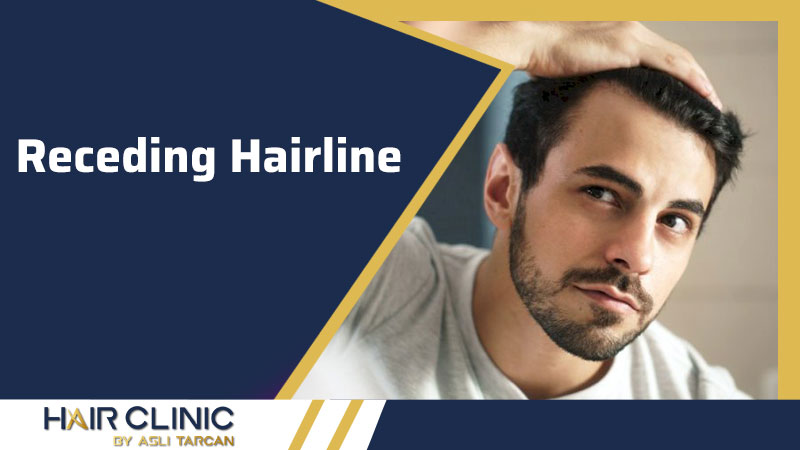Receding Hairline Hairline regression is usually seen at the beginning of baldness. Normally excessive hair loss is known as the onset of baldness for both women and men. However, the opinion of this is determined after a doctor’s examination. After the doctor’s examination, if baldness is detected, the regression of the hairline is checked. Hairline regression is the first stage of baldness. Depending on the hair loss, receding hairline happens.
The hairline, which gradually disappears and regresses due to hair loss, is calculated individually while regeneration. Since the anatomy of each person is different, a standard measurement technique is not mentioned when creating anterior line alignment.
For this reason, it is extremely important to carry out treatment after being examined by a specialist doctor. After the doctor and the patient make a joint decision on the treatment, it is determined where the hairline will start again.
There are multiple factors on which hairline regression depends. These occur depending on age, genetic factors, stress, and facial structure. The treatment to be applied is determined according to the progress of the receding hairline. Hair transplantation is generally applied as a treatment. How much the hairline regresses affects the naturalness of the treatment to be applied.
In the treatment to be applied, the front line is mostly oval or flat in women, the temporal area in men takes a slightly indented shape. At the same time, the hairline is determined by considering the golden ratio. It should never be in alignment, it should follow an indented line like a zigzag.
What Is The Reason For Receding Hairline In Men?
There are 3 main reasons for receding hairline in men. These are genetic predisposition, the presence of testosterone hormone, and the relationship of hair receptors to the male hormone. The first two reasons are not indestructible. However, with applications that limit the formation of DHT, hair loss can be reduced, controlled, and the process of hair loss can be delayed.
It is perfectly normal for every man’s hair to get a little thinner or the front hairline to deepen from the sides. Side frontal lines deepening especially after adolescence are accepted as a part of sexual development. Hair loss in men is not a symptom of disease when it is genetically shaped. It is often part of a man’s maturation process. 90% of hair loss cases in men are defined genetically.
Hair loss genes in men can be passed on to a person from a generation ago, such as grandfather, father, grandfather, uncle, and uncle. It mainly becomes active after puberty, during the period when testosterone production increases. With the effect of the genetic program, hair loss and receding hairline are seen in a period between the ages of 16-30.
Besides the genetic predisposition in the rate and speed of hair loss in men; Factors such as health status, quality of life, smoking and alcohol use, stress level, medications used and diet may also play a role.
What Is The Reason For Receding Hairline In Women?
Among the reasons why the front hairline is far behind in women are hereditary characteristics and female pattern hair loss. One of the biggest reasons for the regression of the front hairline is the beginning of baldness. However, baldness symptoms in women are usually experienced in the entire hair area.
Unlike men, a general thinning and reduction is noticed in all hair. Depending on the way hair is collected, openings may occur on the forehead. In such cases, receding hairline occurs.
Hair transplantation is applied in the case of regression of the front hairline in women. However, before applying this process, some conditions must be met. Before the hair transplantation, it is necessary to make sure that the regression of the existing front hairline has stopped. If hair loss continues, the result of the hair transplantation process cannot achieve the targeted success.
Two different surgical methods can be applied for treatment in women with a wide forehead and hairline. It is the most preferred way to reduce the front hairline in the hair transplantation process. In addition to this process, the aesthetic appearance can be enhanced with an extra hair densification process.
People with receding hairline need to frame the face and forehead area in a way that provides a natural look. When all these features are completed, the hair looks natural.
How To Treat Receding Hairline?
In patients with receding hairline, the treatment should be decided by the doctor first. Generally, the treatment of the receding hairline at the beginning of baldness is done with hair transplantation. In hair transplant treatments, hairline correction is generally provided.
Before these corrections, a personalized hairline design is made. Determining the front hairline design in hair transplantation varies according to the person.
Since there are different head and face shapes, a standard measurement technique cannot be applied. For this reason, the measurements used in the design of the front hairline should be made individually. Apart from the anatomical head structure of the person, personal characteristics such as age and facial structure should also be included in the anterior hairline calculations.
How To Desing Hairline?
To start the receding hairline design, first of all, determinations are made on the transition to the vertical part on the forehead and the horizontal area on the head. The lowest limit that should be and the middle point of this border, which is right in the middle of the two eyebrows, is determined.
This point is considered to be the center of the hairline. The slope that connects the face and the scalp and provides the transition from vertical to horizontal determines the boundary of the natural hairline. The line determined by this angle can be raised a little higher according to the shape of the head and age of the person. Again, this point should have a V-shaped slope down the profile and the direction of the hair must be determined correctly.
The V shape in the frontal hairline should be designed adhering to the shape of the skull and the face. For example, in a wide head structure, the front hairline should form a wide-angle and join with the temple area. In the narrow head structure, this line should be designed as a concave.
How these lines will be curled and how much they should be pulled up or down are determined precisely. The calculations in hair density and distribution at the point where the hairline starts are in the hands of the hair transplant specialist. All these criteria must be planned correctly to eliminate receding hairline effects.



